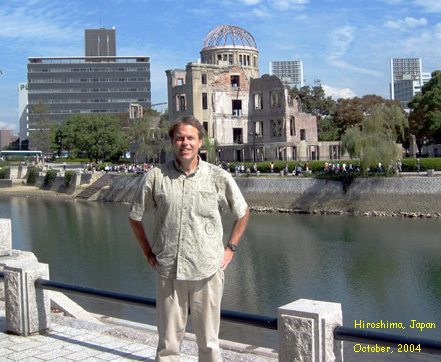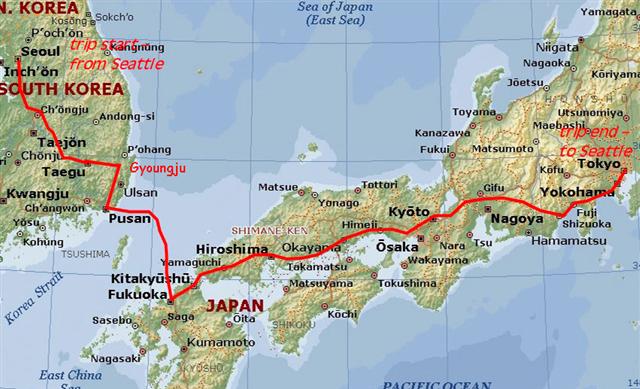|
I had wanted to visit Japan
for a long time. In
Seattle, there are many Japanese people, and a large Japanese influence. But I
had thought that
Japan
was outside of my budget - especially since I am a budget traveller. I had
heard the horror stories of $5 apples or $10 cups of coffee. How can the
Japanese people afford their own country, let alone foreigners who have to
buy yen with their weak currencies?
I learned that Seattle was well known to all Japanese people that I talked
to. I got into the habit of saying "My name is David. I am from
Seattle. Seattle Mariners have Ichiro."
This always lead to ear to ear smiles, words of acknowledgement and
and a series of bows. The Seattle Mariners outfielder Ichiro is from Japan
and is a
national hero in Japan and known to everyone.
I arrived in the port city of Fukouka, in the southwest part of the country. The hydrofoil boat from Pusan,
Korea
had only taken four hours to cross the narrow strait.
As usual, I didn't have any accommodations setup, so I was looking for a hotel. A man
at the boat terminal suggested that there were many hotels in the vicinity
of the train station - a good idea. I took a city bus to the train
station, and then found a tourist office. I was surprised to learn that
they had a service to arrange hotel accommodations also - how convenient! So I asked for a
low-cost Ryokan (Japanese-style Inn) and got one in the neighborhood for
only $34.
Japanese Ryokan
For my 11 day stay in Japan, I always stayed in Ryokans, rather than a western-style hotel. What is a
Ryokan? These are traditional Japanese Inns. When you arrive, you drop
your shoes in the entryway, and don the slippers provided. Your room will
have wall-to-wall tatami mat flooring, which is rice straw organic woven
carpeting. You leave your slippers outside your room in the hall. The
bathroom and shower was down the hall - shared with the other guests. My
room had a futon mattress, sheets and blankets on the floor instead of a
raised bed. You are supplied with a cotton Japanese robe to wear around
your room or in the hallway. My rooms usually had a small color television
and sometimes a telephone. In
Tokyo
, I stayed at the Kimi
Ryokan in the Ikebukuro district. This was recommended by
several sources and was supposed to be a real deal for only $40 per night.
As it turned out, this was my most expensive lodging in Japan.
Like everything else in Japan, these Inns were always clean and neat.
The best feature of Ryokan? My 11 day Japanese
vacation averaged 32 dollars per night (US $) for my lodging! And in the
middle of these huge urban areas - what a pleasant surprise ! !
Japan
can be affordable! !.
Hiroshima
I took the Shinkansen (bullet train) from Fukoaka to Hiroshima. It was very sleek, quiet, and comfortable to be cruising along at 125
miles per hour. In
Hiroshima, I found a ryokan and went down to the Hiroshima
Peace
Park, which is the main tourist attraction and a World Heritage Site.
This park is located along the river and contains quite a bit of open
space. There are monuments and memorials for many groups. This marks "ground zero" where the first atomic blast
occurred during World War II.

Children's Monument for Sadako
Sasaki in the Peace Park
Link for the Hiroshima
city website and Peace Park.
http://www.city.hiroshima.jp/index-E.html
I only stayed one day and one night in Hiroshima. The next day I was off to Kyoto,
Japan’s ancient capital.

Kyoto
The bullet train made quick work of the short
distance between Hiroshima
and Kyoto. I arrived at the new, modern train station and visited the tourist
office on the 9th floor. They made arrangements for
accommodations, and I got a ryokan for only $29 per night. This ryokan
happened to be one recommended by many travel guides and was located in
the vicinity of the Imperial
Palace.
Kyoto
is a city of 1.4 million people and is located in a basin surrounded by
mountains. It contains many ancient temples and shrines and is designated
as a UNESCO
World Heritage site.
My first full day in Kyoto I visited the Imperial
Palace buildings in a tour, then went to the Nijo Castle southeast from
there. Then I walked south to
the Nishi –Honganji
Temple
and also the nearby Higashi – Honganji
Temple.

Japanese Garden at Nijo Castle, Kyoto
My second day, I visited the Kamigamo Shrine near the
river, and then went south to the Kyoto Botanical Gardens.
Then I went further south to the Shimogamo Shrine.


Lotus Pond in Kyoto's Botanical
Gardens
My next day in Kyoto
was in the east part of the city, where most of the temples are located in
the foothills of the mountains. I
first saw the Chionji
Temple, then went east to the Ginkakuji
Temple. It was a holiday weekend
(Sports Day) and there were MANY people at the Temple
– too many for me.
While
walking in the eastern edge of the city, I accidentally stumbled upon a pedestrian walkway along the eastern
foothills known as the “Path of Philosophy”, which linked many
temples. It was very crowded with tourists. I didn't
stop at many temples.

Walking along the "Path of
Philosophy" in Kyoto, but which is "The Way"
My last day I visited
Kiyoizudera
Temple and the nearby National
Museum. Both were very nice.

|

